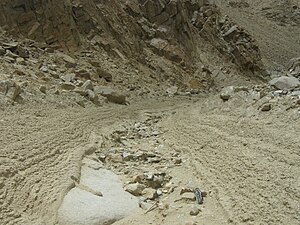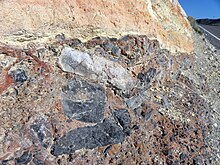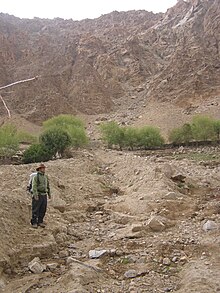Usuari:Uanraf/proves


Debris flows o corrents d'arrossegalls són fenomens geològics en els quals masses de sòl ric en aigua i fragments de roca davallen pels vessants de muntanya, sent canalitzats per canals i torrents i formant dipòsits notables de materials argilosos en els fons de les valls. Generalment tenen densitats aparents comparables a les esllavissades (aproximadament 2000 quilograms per metre cúbic). Tot i això tenen una amplia dispersió dels sediments a causa de les pressions de pors, les quals permeten que el flux flueixi pràcticament com si fos aigua[1]. Quan els Debris flows descendeixen per canals amb molta pendent comunament assoleixen velocitats que sobrepassen els 10 metres per segon (més de 30 Km/h), tot i que els fluxos més cabalosos poden assolir velocitats molt més elevades. Els Debris flows amb volums de 100.000 metres cúbics són prou comuns en muntanyes del món sencer. El flux més gran va tenir volums que excediren el billó de metres cúbics (1 Quilòmetre cúbic). A causa de la seva capacitat de transport de sediment i a les velocitats que assoleixen aquests fenomens poden ser molt destructius.
Els debris-flow fatídicament més remarcables al segle XX són el cas d'Armero, Colòmbia al 1985 amb més de 20.000 morts i l'Estat de Vargas, Veneçuela amb deu mil morts al 1999.
Característiques i funcionament
[modifica]Els debris flow es componen per més d'un 40 o 50% en volum de sediments i la resta consisteix en aigua. Per definició , "debris" o esvaldregalls inclouen sediments amb grans volumetries de diverses mides i formes, comunament des de partícules argiloses microscòpiques a grans blocs de pedra. Als mitjans de comunicació sovint s'usa el terme colades de fang o mudflows per descriure els debris flows tot i que les colades de fang estan compostos majoritàriament per partícules inferiors a la mida sorra. En ambients continentals les colades de fang són molt menys comunes que els debris flows, no obstant, en ambients submarins de marges continentals les colades de fang són molt més comunes i generen dipòsits tipus turbidítics. Els debris flow en regions boscoses poden contenir grans quantitats de restes forestals com troncs o peus d'arbres. Les inundacions causades per fluxos rics en sediments (amb concentracions d'entre 10 i 40%) generen un altre tipus de fluxos anomenats fluxos hiperconcentrats[2] Els corrents normalment contenen concentracions inferiors de sediments.
Els Debris flows poden ser causats per una pluja intensa o per fusió nival, el trencament d'una presa o per una esllavissada associada o no associada a una pluja intensa. En tots els casos un condicionant imprescindible per l'inici d'un debris flow és la presència de pendents superiors als 25 graus, una abundància de sediments solts, sòls o roca alterada, i suficient aigua per transportar el material a un estat de quasi saturació. Els debris flows són més freqüents després d'incendis. Suposen un risc important a les zones muntanyoses i tenen especial atenció a Japó, Xina, Taiwan, USA, Canada, Nova Zelanda, les Filipines, els Alps Europeus, els Pirineus, Rússia i Kazakhstan. Al Japó un gran debris flow és anomenat yamatsunami (山津波), literalment muntanya tsunami.

Debris flows are accelerated downhill by gravity and tend to follow steep mountain channels that debouche onto alluvial fans or floodplains. The front, or 'head' of a debris-flow surge often contains an abundance of coarse material such as boulders and logs that impart a great deal of friction. Trailing behind the high-friction flow head is a lower-friction, mostly liquefied flow body that contains a higher percentage of sand, silt and clay. These fine sediments help retain high pore-fluid pressures that enhance debris-flow mobility. In some cases the flow body is followed by a more watery tail that transitions into a hyperconcentrated stream flow. Debris flows tend to move in a series of pulses, or discrete surges, wherein each pulse or surge has a distinctive head, body and tail.

Debris-flow deposits are readily recognizable in the field. They make up significant percentages of many alluvial fans and debris cones along steep mountain fronts. Fully exposed deposits commonly have lobate forms with boulder-rich snouts, and the lateral margins of debris-flow deposits and paths are commonly marked by the presence of boulder-rich lateral levees (aquí posarem Levees o dics). These natural levees form when relatively mobile, liquefied, fine-grained debris in the body of debris flows shoulders aside coarse, high-friction debris that collects in debris-flow heads as a consequence of grain-size segregation (a familiar phenomenon in granular mechanics). Lateral levees can confine the paths of ensuing debris flows, and the presence of older levees provides some idea of the magnitudes of previous debris flows in a particular area. Through dating of trees growing on such deposits, the approximate frequency of destructive debris flows can be estimated. This is important information for land development in areas where debris flows are common. Ancient debris-flow deposits that are exposed only in outcrops are more difficult to recognize, but are commonly typified by juxtaposition of grains with greatly differing shapes and sizes. This poor sorting of sediment grains distinguishes debris-flow deposits from most water-laid sediments.
Tipus
[modifica]Uns altres fluxos que geològicament es poden descriure com debris flows i que tenen noms més específics poden incloure:
Lahar
[modifica]Un lahar és un debris flow relacionat a alguna activitat volcànica, directament com a resultat d'una erupció o indirectament a causa del col·lapse de materials solts als flancs del volcà. Una gran varietat de fenomens poden iniciar un lahar, incloent la fosa de gel glacial a causa d'activitat volcànica, pluja intensa sobre material piroclàstic no consolidat, o l'explosió d'un embassament tancat per sediments glacials o piroclàstics. El mot lahar és d'origen Indonesi però és d'ús corrent entre els geòlegs per descriure els debris flows volcanogènics. Quasi tots els majors i més destructius debrsi flows del món tenen origen en volcans. Un exemple és el lahar que va inundar la ciutat de Armero, Colombia.
Jökulhlaup
[modifica]El jökulhlaup és un flux degut a explosió glacial. Jökulhlaup és un nom Islandès ja que a Islàndia molts fluxos glacials són causats per erupcions volcàniques sub-glacials (Islàndia està siutada a la falla Mig-Atlàntica,
is an Icelandic word, and in Iceland many glacial outburst floods are triggered by sub-glacial volcanic eruptions. (Iceland sits atop the Mid-Atlantic Ridge, which is formed by a chain of mostly submarine volcanoes). Elsewhere, a more common cause of jökulhlaups is the breaching of ice-dammed or moraine-dammed lakes. Such breaching events are often caused by the sudden calving of glacier ice into a lake, which then causes a displacement wave to breach a moraine or ice dam. Downvalley of the breach point, a jökulhlaup may increase greatly in size through entrainment of loose sediment from the valley through which it travels. Ample entrainment can enable the flood to transform to a debris flow. Travel distances may exceed 100 km.
Theories and models of debris flows
[modifica]Numerous different approaches have been used to model debris-flow properties, kinematics, and dynamics. Some are listed here.
- Rheologically based models that apply to mud flows treat debris flows as single-phase homogeneous materials (Examples include: Bingham, viscoplastic, Bagnold-type dilatant fluid, thixotropic, etc.)
- Dam break wave, e.g. Hunt,[3] Chanson et al.[4]
- Roll wave, e.g., Takahashi,[5] Davies[6]
- Progressive wave[7]
- A type of translating rock dam[8]
Two-phase
[modifica]The mixture theory, originally proposed by Iverson[1] and later adopted and modified by others, treats debris flows as two-phase solid-fluid mixtures.
In real two-phase (debris) mass flows there exists a strong coupling between the solid and the fluid momentum transfer, where the solid's normal stress is reduced by buoyancy, which in turn diminishes the frictional resistance, enhances the pressure gradient, and reduces the drag on the solid component. Buoyancy is an important aspect of two-phase debris flow, because it enhances flow mobility (longer travel distances) by reducing the frictional resistance in the mixture. Buoyancy is present as long as there is fluid in the mixture.[9] It reduces the solid normal stress, solid lateral normal stresses, and the basal shear stress (thus, frictional resistance) by a factor (), where is the density ratio between the fluid and the solid phases. The effect is substantial when the density ratio () is large (e.g., in the natural debris flow).
If the flow is neutrally buoyant, i.e., , (see, e.g., Bagnold,[10] 1954) the debris mass is fluidized and moves longer travel distances. This can happen in highly viscous natural debris flows.[11] For neutrally buoyant flows, Coulomb friction disappears, the lateral solid pressure gradient vanishes, the drag coefficient is zero, and the basal slope effect on the solid phase also vanishes. In this limiting case, the only remaining solid force is due to gravity, and thus the force associated with buoyancy. Under these conditions of hydrodynamic support of the particles by the fluid, the debris mass is fully fluidized (or lubricated) and moves very economically, promoting long travel distances. Compared to buoyant flow, the neutrally buoyant flow shows completely different behaviour. For the latter case, the solid and fluid phases move together, the debris bulk mass is fluidized, the front moves substantially farther, the tail lags behind, and the overall flow height is also reduced. When , the flow does not experience any buoyancy effect. Then the effective frictional shear stress for the solid phase is that of pure granular flow. In this case the force due to the pressure gradient is altered, the drag is high and the effect of the virtual mass disappears in the solid momentum. All this leads to slowing down the motion.

Damage prevention
[modifica]In order to prevent debris flows reaching property and people, a debris basin may be constructed. Debris basins are designed to protect soil and water resources or to prevent downstream damage. Such constructions are considered to be a last resort because they are expensive to construct and require commitment to annual maintenance.[13]
See also
[modifica]- Colluvium
- Illhorn below which lies Illgraben a popular debris flow tourist spot
- Landslide classification
- Rheology
References
[modifica]Notes
- ↑ 1,0 1,1 Iverson, R.M., 1997, The physics of debris flows, Reviews of Geophysics, 35(3): 245-296.
- ↑ Pierson, Thomas C. Distinguishing between debris flows and floods from field evidence in small watersheds. US Department of the Interior, US Geological Survey, 2005.
- ↑ Hunt,B. (1982). "Asymptotic Solution for Dam-Break Problems." Jl of Hyd. Div., Proceedings, ASCE, Vol. 108, No. HY1, pp. 115-126.
- ↑ Hubert Chanson, Sebastien Jarny & Philippe Coussot «Dam Break Wave of Thixotropic Fluid». Journal of Hydraulic Engineering, ASCE,, vol. 132, 3, 2006, pàg. 280–293. DOI: 10.1061/(ASCE)0733-9429(2006)132:3(280).
- ↑ Takahashi, T., 1981. Debris flow, Annu. Rev. Fluid Mech., 13, 57–77.
- ↑ Davies,T.R.H. 1986. Large debris flows: a macro-viscous problem. Acta Mechanica, 63, 161-178.
- ↑ Hungr,O. 2000. Analysis of debris flow surges using the theory of uniformly progressive flow. Earth Surface Processes and Landforms, 25, 483-495
- ↑ Coleman, P. F., 1993. A new explanation for debris flow surge phenomena (abstract), Eos Trans. AGU, 74(16), Spring Meet. Suppl., 154.
- ↑ E. B., Pitman and L. Le «A two-fluid model for avalanche and debris flows». Philosophical Transactions of the Royal Society A, vol. 363, 2005, pàg. 1573–1602. DOI: 10.1098/rsta.2005.1596.
- ↑ R. A. Bagnold «Experiments on a gravity-free dispersion of large solid spheres in a Newtonian fluid under shear». Proceedings of the Royal Society A, vol. 225, 1954, pàg. 49–63. DOI: 10.1098/rspa.1954.0186.
- ↑ B. W., McArdell, P. Bartelt, and J. Kowalski «Field observations of basal forces and fluid pore pressure in a debris flow». Geophys. Res. Lett.,, vol. 34, 2007. DOI: 10.1029/2006GL029183.
- ↑ Jakob, Matthias; Hungr, Oldrich «Debris-flow hazards and related phenomena». Debris-Flow Hazards and Related Phenomena. Springer, 2005, pàg. 38–39. Bibcode: 2005dfhr.book.....J.
- ↑ «Debris Basins». U.S. Fish & Wildlife Service. [Consulta: 30 gener 2013].
Further reading
- McPhee, John. The Control of Nature. New York: Noonday Press (Farrar, Straus & Giroux, 1989 ISBN 0-374-12890-1)
External links
[modifica]- Dongchuan Debris Flow Observation and Research Station, China
- Video documentation of experiments at the USGS debris-flow flume, Oregon, USA
- Mass Movements. Section of the information platform "Natural hazards in Switzerland"
- Washington State information about Debris flows, and related material




